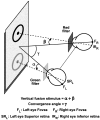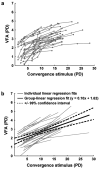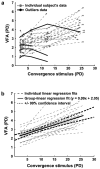Variation of binocular-vertical fusion amplitude with convergence
- PMID: 17389488
- PMCID: PMC2198903
- DOI: 10.1167/iovs.06-1018
Variation of binocular-vertical fusion amplitude with convergence
Abstract
Purpose: The maximum binocular vertical disparity that can be fused with disparity vergence (vertical-fusion amplitude or VFA), varies with convergence angle. VFA is larger for convergence responses to near than to far viewing distances; however, the clinical norms for changes in VFA with convergence have not been established. VFA at several convergence angles was measured to obtain a quantitative description of the changes in VFA with convergence.
Methods: Fifty-six adults took part in the study. Horizontal and vertical disparity stimuli were presented on a computer monitor by using the red-green anaglyphic technique. Stimulus to convergence was altered either by changing horizontal disparity on the computer monitor (experiment I: nine horizontal disparities: 1.2-22.5 PD [Delta]) or by changing the binocular viewing distance (experiment II: five viewing distances: 25-300 cm). Convergence was held constant during an experimental session, while vertical disparity was incremented in steps of 0.05 Delta after a subjective report of fusion, until the subject reported diplopia. The maximum vertical disparity that could be fused was defined as the VFA.
Results: VFA increased linearly over the range of convergence stimuli (y = 0.10x + 1.62) and intersubject variability of VFA increased marginally with the amount of convergence. Linear regression equations with similar slopes and y-intercepts were observed in experiments I and II.
Conclusions: The results of the experiments provide a quantitative description of a linear relationship between VFA and convergence. The linear regression equation could be used in a clinical setting to establish norms and to screen for vertical vergence abnormalities.
Figures





Similar articles
-
Target Properties Effects on Central versus Peripheral Vertical Fusion Interaction Tested on a 3D Platform.Curr Eye Res. 2017 Mar;42(3):476-483. doi: 10.1080/02713683.2016.1196704. Epub 2016 Jul 15. Curr Eye Res. 2017. PMID: 27419270
-
Response pattern asymmetry of binocular vision vertical fusion amplitudes in a normal population.Binocul Vis Strabismus Q. 2008;23(1):23-30. Binocul Vis Strabismus Q. 2008. PMID: 18393936
-
Short-latency disparity vergence responses and their dependence on a prior saccadic eye movement.J Neurophysiol. 1996 Apr;75(4):1392-410. doi: 10.1152/jn.1996.75.4.1392. J Neurophysiol. 1996. PMID: 8727386
-
A comparative analysis of vertical and horizontal fixation disparity in sentence reading.Vision Res. 2015 May;110(Pt A):118-27. doi: 10.1016/j.visres.2015.03.008. Epub 2015 Apr 1. Vision Res. 2015. PMID: 25839421
-
Binocular fusion, suppression and diplopia for blurred edges.Ophthalmic Physiol Opt. 2014 Mar;34(2):163-85. doi: 10.1111/opo.12108. Epub 2014 Jan 29. Ophthalmic Physiol Opt. 2014. PMID: 24476421 Free PMC article. Review.
Cited by
-
Vertical vergence in nonhuman primates depends on horizontal gaze position.Strabismus. 2019 Sep;27(3):172-181. doi: 10.1080/09273972.2019.1629465. Epub 2019 Jun 21. Strabismus. 2019. PMID: 31223057 Free PMC article.
-
Subclinical Ocular Motility Dysfunction and Extraocular Muscle Changes in Inactive Graves' Orbitopathy.J Pers Med. 2024 Aug 10;14(8):848. doi: 10.3390/jpm14080848. J Pers Med. 2024. PMID: 39202039 Free PMC article.
-
Functional anatomy of human extraocular muscles during fusional divergence.J Neurophysiol. 2018 Nov 1;120(5):2571-2582. doi: 10.1152/jn.00485.2018. Epub 2018 Sep 19. J Neurophysiol. 2018. PMID: 30230991 Free PMC article.
-
Binocular fusion enhances the efficiency of spot-the-difference gameplay.PLoS One. 2021 Jul 20;16(7):e0254715. doi: 10.1371/journal.pone.0254715. eCollection 2021. PLoS One. 2021. PMID: 34283852 Free PMC article.
-
Functional Anatomy of Muscle Mechanisms: Compensating Vertical Heterophoria.Am J Ophthalmol. 2021 Jan;221:137-146. doi: 10.1016/j.ajo.2020.09.002. Epub 2020 Sep 9. Am J Ophthalmol. 2021. PMID: 32918906 Free PMC article.
References
-
- Howard IP, Rogers BJ. Binocular vision and stereopsis. Oxford: Oxford University; 1998.
-
- Schor CM, Maxwell JS, Stevenson SB. Isovergence surfaces: the conjugacy of vertical eye movements in tertiary positions of gaze. Ophthalmic Physiol Opt. 1994;14:279–286. - PubMed
-
- Berens C, Losey RR, Hardy LH. Routine examination of the ocular muscles and nonoperative treatment. Am J Ophthalmol. 1927;10:910–918.
-
- Hara N, Steffen H, Roberts DC, Zee DS. Effect of horizontal vergence on the motor and sensory components of vertical fusion. Invest Ophthalmol Vis Sci. 1998;39:2268–2276. - PubMed
-
- Parks M. Vergences. In: Tasman W, Jaeger EA, editors. Duane’s Clinical Ophthalmology. Philadelphia: Lippincott Williams and Wilkins; 2005.
Publication types
MeSH terms
Grants and funding
LinkOut - more resources
Full Text Sources

